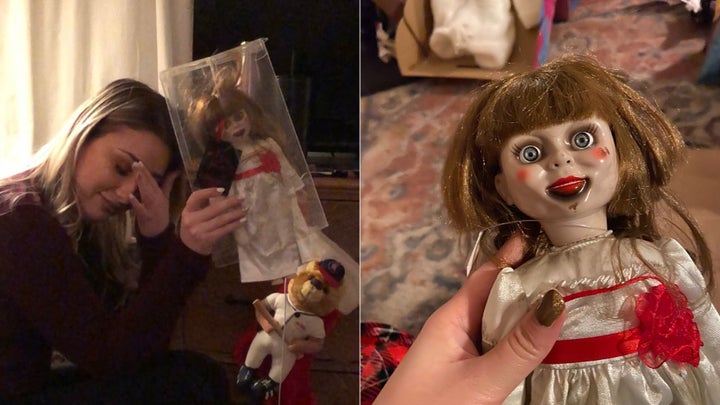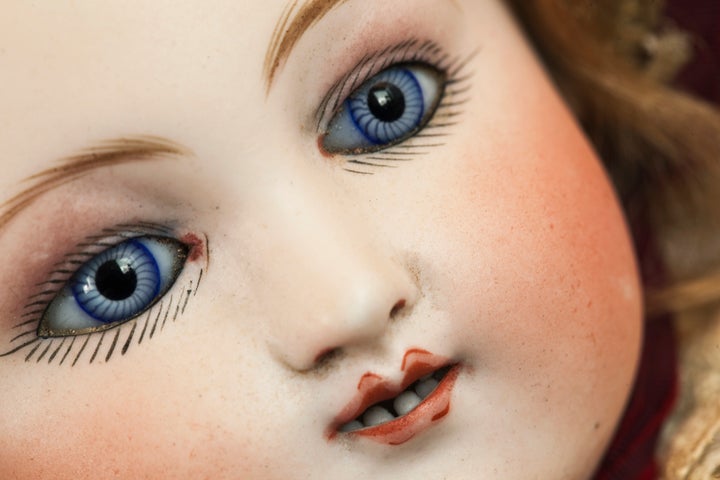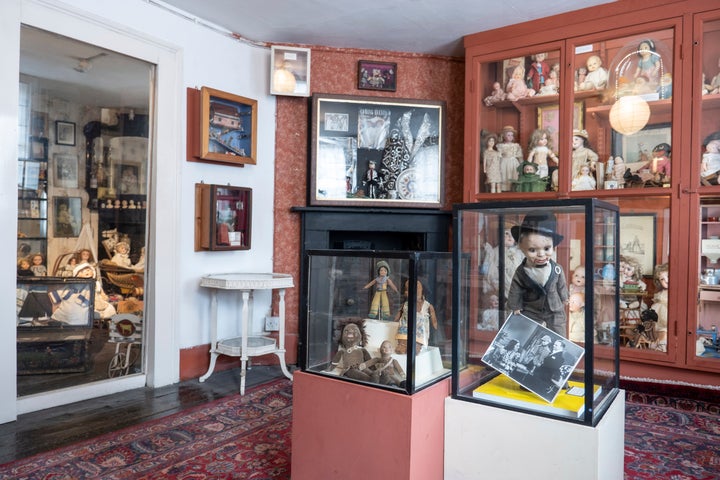Here’s Why You’re Afraid Of Dolls, According To Experts
For years we had a running gag in my family where on Christmas I’d sometimes wrap up an Annabelle doll and pass it off as a gift for my little sister.
The doll ― sent to our newsroom as a promotional item for “The Conjuring” series that features the toy ― is now stored in my mom’s garage, but for a while it scared the crap out of my sister. She’d open it, shriek and toss it across the room ― and hate us for a few minutes, justifiably: If you’re in the middle of unwrapping sweaters and other more conventional gifts, like my sister was, Miss Annabelle ― with that giddy forced smile and eyes that seem to track you ― is absolutely going to take you aback. In our family, the doll was the ultimate Christmas jump scare.

If you’re afraid of dolls, Annabelle (who’s actually based on a real doll, yikes) is probably among the movie killer dolls that lives rent-free in your head: There’s the king of killer dolls himself, Chucky, and his bride, Tiffany. There’s Brahms, a creepy little Jared Kushner-looking doll that terrorizes a nanny in “The Boy.”
In 2022, there’s Megan, the highly meme-able evil robot doll from the recently released “M3GAN.” (The AI doll is programmed to be a child’s greatest companion by a brilliant roboticist at a toy company, but, alas, Megan defaults to a movie doll’s evil ways.)
Then, of course, there’s the iconic ventriloquist’s dolls: Billy the puppet from the “Saw” franchise, Slappy the dummy from the ’90s “Goosebumps” franchise.
My personal favorite homicidal doll? Talky Tina from a 1963 episode of “The Twilight Zone” ― a sassy, freckle-faced toy that mocks and threatens the schmucky stepdad of her little-girl owner. (“My name is Talky Tina, and I’m beginning to hate you,” she tells the guy with a pivot of her little doll head, endearing herself to sulky stepkids everywhere.)
Clearly, humans have a tricky, complicated relationship with the dolls ― a relationship that’s too good not to mine for content. In the spirit of that ― and because it’s spooky season ― we talked to experts about why so many of us are freaked out by dolls.
The fear of dolls is known as ’pediophobia.′
There’s a name for the intense fear of dolls: “pediophobia.” For those with pediophobia, seeing a commercial for the new Chucky show or encountering an old-timey porcelain doll can trigger some pretty severe anxiety symptoms: rapid, shallow breathing and lightheadedness.
According to Healthline, pediophobia is a type known as a specific phobia, an irrational fear of something that poses no real threat. Pediophobia is closely related to pupaphobia, a fear of puppets. An estimated 9.1% of Americans, more than 19 million people, have a specific phobia.
For most people, their uneasiness around dolls is not a full-blown phobia, but it’s enough to avoid a killer doll movie or gazing too hard at a cabinet full of porcelain dolls.
Heightened doll dislike may have something to do with their eyes, said Katriina Heljakka, a toy and play researcher at the University of Turku in southwestern Finland and the author of the paper “Disliked and Demonized Dollies: Pediophobia and Popular Toys of the Present.”
“Dolls are toys with faces, and in philosophical terms, eyes are the gateway to the soul,” the researcher told HuffPost. “Dolls have the capacity to stare at us and ‘see everything,’ while us looking at them does not make them react.”

Life-like dolls take us into ‘the uncanny valley.’
The creepy quotient of dolls might also have something to do with what’s called “the uncanny valley.”
First coined in the 1970s by Masahiro Mori, then a professor at the Tokyo Institute of Technology, Mori used the phrase to describe the eerie, uneasy feeling people experience when human-looking robots start to look too much like humans. (Up to that point, Mori noted that humans feel relatively comfortable around robots.)
The robot isn’t fully human-like and isn’t fully robot-like either, and that unfamiliar mix gives humans a sense of eeriness. We don’t know how to read the robot, so we default to “creeped out.”
Dolls that straddle that same line creep us out, too, said David Kupferman, an associate professor of education at the Minnesota State University at Moorhead and author of the essay “Toy Gory, or the Ontology of Chucky: Childhood and Killer Dolls.”
“Occasionally you’ll come across a doll whose eyes will move from side to side, or the lids will close and open if you tilt its head,” he told HuffPost. “There’s an uneasy aloofness there, as if the doll has the ability to watch you even as you move around the room.”
Talking dolls from the midcentury, like Chatty Cathy, are creepy enough ― all those jerky movements and scratchy voice recordings ― but newer dolls that veer further into robotics (like the fictional “M3GAN” or the popular Luvabella robotic baby doll) are even more unnerving to some people.
“Our collective unconscious is so filled up with dystopian narratives of robots taking control over humans that we cannot escape these references,” said Francesco Spampinato, an associate professor of contemporary art history and visual culture in the department of the arts at the University of Bologna and the author of “Body Surrogates: Mannequins, Life-Size Dolls, and Avatars.”
Then there’s the fact that dolls never die. (Granted, they may need a charge or new batteries now and then.)
“Humanlike robots and avatars put us in front of the ultimate truth: We’re going to die while they’ll live forever,” Spampinato told HuffPost.
Dolls that are too lifelike also trigger responses in us that anthropomorphize them and treat them like actual humans. In Heljakka’s research on pediophobia, the adult women she studied even felt compelled to dress naked dolls, especially baby dolls, as if the toys had crossed over to humanness and needed to be covered.
“Humans have this tendency of empathy and need for nurturing for humanlike things, especially adult women, perhaps due to maternal instinct,” Heljakka said.
Why aren’t kids as freaked out by dolls?
In a fascinating article on pediophobia that ran in the Smithsonian in 2015, writer Linda Rodriguez McRobbie described a common reaction visitors had when entering a room full of porcelain dolls at Pollock’s Toy Museum in London.
“Some visitors to the museum can’t manage the doll room, which is the last room before the museum’s exit; instead, they trek all the way back to the museum’s entrance, rather than go through. ‘It just freaks them out,’ says Ken Hoyt, who has worked at the museum for more than seven years. He says it’s usually adults, not children, who can’t handle the dolls. And it happens more often during the winter, when the sun goes down early and the rooms are a bit darker.”
Why don’t little kids always feel the same way about dolls as adults do?
“Because they have been alive longer, adults have more fixed ideas about the nature of dolls than kids,” said Frank T. McAndrew, a professor of psychology at Knox College in Galesburg, Illinois, who studies creepiness, among other things.
“This can lead us to be more quickly creeped out by them when they aren’t what we expect,” he told HuffPost.

Adults are also keenly aware of the cruelty that humans are capable of, and if we think of dolls as the images of the human, we also project possible malevolent human behavior on them, according to Heljakka.
“In other words, the evil of dolls is the same kind of evil humans express toward other humans,” she said.
At the same time, dolls ― at least the Victorian-looking porcelain dolls your grandma used to collect ― are the very picture of innocence: cheery, rose-colored cheeks, long glistening hair, glassy doe eyes.
“Possessed dolls as a trope of fiction is a popular and seemingly everlasting form of entertainment because the juxtaposition of innocence and evil makes our imaginations run wild,” Heljakka said.
There’s other theories, too. Interestingly, Kupferman thinks adults’ fascination with creepy and killer dolls in horror movies may have something to do with how we relate to children.
“I think adults’ fear of killer dolls is rooted in adults’ fear of children, specifically children as unknowable,” he said. “We don’t really understand the inner lives of children, so we ascribe this weird, eerie ability to cross over into the unknown with them.”
Horror movies with killer dolls play on all these fears and more.
When “Annabelle” was released in 2014, director John Leonetti explained why he thinks dolls make such great vehicles for horror movies in an interview with HuffPost.
“If you think about them, most dolls are emulating a human figure,” Leonetti said. “But they’re missing one big thing, which is emotion. So they’re shells. It’s a natural psychological and justifiable vehicle for demons to take it over. If you look at a doll in its eyes, it just stares. That’s creepy. They’re hollow inside. That space needs to be filled.”
The fact that we consciously know that dolls are lifeless but still feel unsure about them creates a tension that horror film creators like Leonetti love to play with, McAndrews said.
“Combine the uncanny valley with the other sinister qualities we see in horror movie dolls and we become very uncomfortable indeed,” he said. “The morphing of something that is supposed to be a cute, cuddly plaything into something that wants to murder us is terrifying.”
Credit: Source link